[Syria’s Apex Generation highlights post-uprising art as an introduction to the rich history of painting in Syria. Featuring the works of Abdul Karim Majdal Al-Beik, Nihad Al Turk, Othman Moussa, Mohannad Orabi, and Kais Salman, the exhibition and its accompanying publication explore a new school of painting in the midst of expansion despite the disintegration of the Damascus art scene, its original center. Informed by extensive traditions of expressionism, symbolism, and abstraction, this burgeoning group has forged ahead with the creative objectives of their predecessors, who advocated the social relevance of art.
The essay below is reproduced from the exhibition’s publication. Due to the essay`s length, its text has been divided between two posts. Part Two appears below. Part One can be found here. Syria’s Apex Generation is curated by the author and opens at Ayyam Gallery’s Al Quoz and DIFC locations in Dubai on 9 June and at Ayyam Gallery Beirut on 11 June.]
Interior Isolation, Exterior Deformation
When Syria’s political climate became increasingly bleak in the 1980s, artists mined “the given social condition” through unrestrained approaches. Marking the height of Syrian Expressionism, color reached unprecedented concentrations of radiance, although palettes remained tinted with undercoats of black, and seismic lines began to shudder with the fragile loci of human subjects. At the center of Syria’s final phase in art of the twentieth century were explorations of the body, particularly deformation as a metaphor for veiled turbulence. In contrast to protagonists patterned after the muscular frames of ancient prototypes or the elegant contours of saints, the figure in Syrian art became disproportionate, fragile, and transitory.
In The Logic of Sensation, a treatise on the paintings of Francis Bacon, Gilles Deleuze proposes that deformation as an artistic vehicle is always static, occurring at a single position, as it “subordinates movement to force.”[15] As Deleuze further maintains, “deformation is obtained in the form at rest; and at the same time, the whole material environment, the structure, begins to stir.” Alongside varying degrees of altered physicality, space is critical to conveying the “invisible and insensible forces” that impact the body and lead to its transformation.
As Syria experienced a period of severe isolation in the 1990s, seclusion became a common theme for a number of artists, most visibly for Saad Yagan (b. 1944) and Safwan Dahoul (b. 1961), whose elongated, contorted subjects are confined to solitary interiors. Nazir Ismail (b. 1949) relied on irregular forms in shadowy figures that appear as phantoms of former selves; in the absence of mouths, his mask-like faces remain silent. Artists seeking to make broader statements about the human condition and the general corrosion of social institutions included Ali Moukawas (b. 1955) and Ahmad Moualla (b. 1958), who painted masses of frenzied bodies that overwhelm allegorical scenes. While malformed figures also appear in the works of sculptors such as Assem El Bacha (b. 1948) and Mustafa Ali (b. 1959), the dimensional limitations of painting proved critical as conceptual apertures to enclosed sites.
A precedent for this take on deformation can be traced to Germany-based painter Marwan Kassab Bachi (b. 1934) whose paintings allude to exile as a palpable rupture. Working in Berlin since the late 1950s, Marwan’s early expressionist portraits capture the misshapen body as ingress to the psyche. Full-length pictures acquire grotesque accents as subjects are paused just before apparent disintegration.
The émigré’s later paintings of collapsed heads frequently include elements of self-portraiture and seem to possess traces of earth as a reference to Syrian landscapes.[16] A 1985 etching by the artist titled Head shows an enlarged face layered with mounds of markings. Hidden beneath a surface resembling arid soil, its features are nearly indistinguishable. The slender apparition occupies the expanse of the composition, destabilizing the viewer’s perception of spatial depth.
In the ethereal works of Saad Yagan weary men appear physically impaired by the arduous passage of time as they assemble at sparse cafés. Their shoulders mirror receding expressions as sunken faces are near carbon copies with the exception of slight variations. Triangular shadows cut across arrangements of single patrons, pairs, or small groups in interiors that are painted in shades of blue but anchored by select areas of flame-color reds. A single opening to the outside world provides just enough light to highlight the sedentary figures. Thinkers, barflies, daydreamers, and recluses are scattered in darkened rooms although outnumbered by empty tables and chairs. These cavernous sites were painted from observation in the artist’s native Aleppo where he frequented taverns throughout his career, ten years of which were spent in the company of Louay Kayyali.
Disaffection is conveyed in the details of Ahmad Moualla’s tempestuous scenes. Depicting large gatherings of obscured figures that merge or break apart at certain points, the artist employs theatrical forms such as tragedy, melodrama, and spectacle in monumental compositions that bring to mind the grandness of Baroque historical painting. An untitled mixed media work executed in 1999 shows a public square where a throng assembles at the base of an elevated platform. Atop the stand is a bull, recalling the biblical story of the golden calf. While most onlookers peer up at the beast, a handful of thawed protagonists attempt to exit the plaza. In the upper portion of the painting towering wardens survey the event. Beneath them abstracted areas of white are shown as immaterial forces that spill onto the crowd with ruinous power.
By the early 1990s, the lean figures of Safwan Dahoul’s Dream series (1987-) began to acquire lengthened body proportions, resembling the asymmetrical attributes of Pharaonic art from the Amarna Period. The willowy woman of his works, whom he often pairs with her equally lithe lover, is portrayed in the quiet of domesticity: in moments of slumber or stationary in languid poses. Dahoul’s interiors are sparse and only include the structural elements that are necessary to set compositions, making the focus of his paintings the curved spine and bent limbs of his heroine. The wiry hands of his figures also feature prominently, primarily in depictions where the couple is physically entangled, and are reminiscent of those found in fifteenth-century Flemish icon painting. Such modeling of what might seem inconsequential to the composition, in fact, has weighty inferences. The hands of his figures evoke the extremities of Mary in the crucifixion scenes of painter Rogier van der Weyden and can thus be understood as indicators of inconsolable sorrow. This historical influence is evident due to Dahoul’s time in Belgium, where he pursued a Doctorate from the Higher Institute of Plastic Arts in Mons between 1987 and 1997. Several works from this stage of the artist’s oeuvre explore the compositional formats of traditional iconography and religious alters.
Adding to the subtle deformation of his figures is the artist’s division of space, which creates a clear tension between the body and the implied mechanisms that contain it. Walls, windows, tables, and chairs are arranged to create impenetrable barriers. His figures struggle to find shelter as these fixtures close in.
Dahoul’s heroine is modeled after his late wife, artist Nawar Naser (1962-2008), while the male protagonist who frequently appears alongside her serves as an evolving self-portrait. Dahoul began numbering his Dream paintings after her passing. As the series progressed he incorporated other symbols such as masks, a deck of playing cards, and a halo. The bodies of his subjects hardened, becoming stone-like and sculptural yet still coiled. The domestic interiors enclosing his portraits slowly dematerialized, morphing into black voids. In 2000, color left his palette, imparting contrasts in dark and light, a development he attributed to the “colorless” streets of Syria. Several years later, Dahoul told a Syrian magazine: “Our souls have been affected to such an extent that we now fear color.”[17]
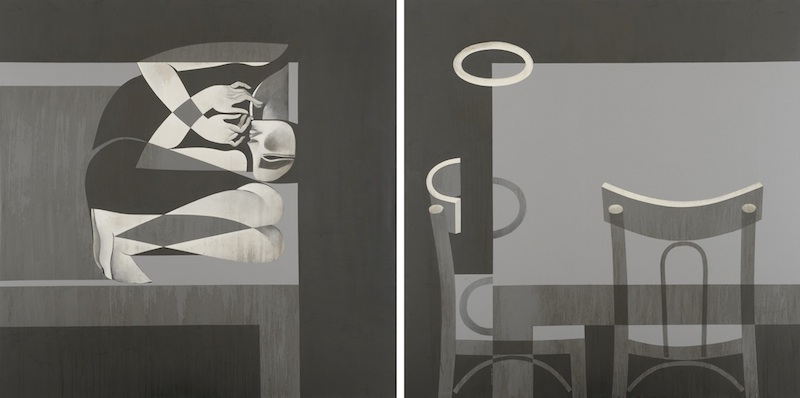 [Safwan Dahoul, Dream 27 (2010). Image courtesy of Ayyam Gallery.]
[Safwan Dahoul, Dream 27 (2010). Image courtesy of Ayyam Gallery.]
A survey of Syrian art over the second half of the twentieth century reveals the accrual of formal techniques and a maturation of concepts in the works of Saad Yagan, Nazir Ismail, Ahmad Moualla, and Safwan Dahoul. Examples from the 1990s also confirm that expressionism, allegory, and symbolism all constitute branches of Syrian realism. As the twenty-first century began, a new generation of painters embarked on the path of the many artists before them.
Syria’s Apex Generation
During the early 2000s Syria’s art scene experienced significant growth as nationwide economic reform policies were implemented. New galleries opened; numerous events were launched in partnership with organizations abroad; and the rising profiles of established art spaces like Le Pont Gallery in Aleppo continued to attract international artists and curators. These factors, combined with a push from the rise of an art market in the Gulf, changed how art was created, distributed, and received. True to form, the nature of this renewal ignited debates. The intellectual fervor resulting from such public volleying, although tense at times, provided vital stimulus, even among outspoken cynics. Undeniably, support from diverse proponents allowed Syrian art to develop at a rapid pace.
In 2007 Ayyam Gallery Damascus held a competition for young painters. From one hundred and fifty applicants, ten were selected to join an in-house program for emerging artists while also receiving representation. Shortly after the Shabab Ayyam incubator was launched with the winners of the open call, a tight-knit circle formed around the gallery’s happenings and regularly convened at the local studios of its members. Most of the group’s painters graduated from the Faculty of Fine Arts, Damascus, where they studied under Elias Zayat, Nazir Nabaa, Nizar Sabour (b. 1958), Safwan Dahoul, and Bassem Dahdouh (b. 1964).
Abdul Karim Majdal Al-Beik, Nihad Al Turk, Othman Moussa, Mohannad Orabi, and Kais Salman were brought together under the umbrella of Shabab Ayyam. When first encountering their varied paintings, it is perhaps difficult to locate the aesthetic threads that link them other than the subject of today’s conflict. Yet the post-uprising art that appears in Syria’s Apex Generation serves as an introduction to a broader cultural history, the nuances of which can be found throughout the canvases of its artists. The featured works represent a new school of painting that is preserving the notion of art as an act of rebellion.
Despite the invariable sense of severance shadowing the Syrian art scene as it now functions in small clusters throughout the Arab world, artists remain connected through the shared impulse of responding to the war with visible urgency. Although the onset of the conflict brought the peak of the cultural revival in Damascus to an abrupt end, the momentum that carried it has been retained by this productivity. Logistical issues such as the constraints of transit or the burden of addressing viewers across digital platforms have led some to abandon painting or sculpture for the convenience of photography, video, and graphic art. This phenomenon has produced a broad index of imagery that subverts and intervenes when widely distributed, upturning the media spectacle of the war. Others, such as the painters of Syria’s Apex Generation, have amended their formal approaches to access the recesses that are buried by competing political narratives. What is remarkable about this phase is that the critical direction of Syrian art has not been compromised—in most cases such trials have refocused the merger of subjectivity with objectivity in search of effective form.
Dispatches from the Apex
In his large-scale mixed media works, Abdul Karim Majdal Al-Beik transforms unconventional materials such as charcoal, plaster, starch, ash, and burlap into evocative mediums that reproduce the patina of imbued surfaces. Basing his “combine paintings” on the weathered layers of graffiti, markings, and cracks that can be found on the exterior surfaces of public spaces, he seeks to explore how such understated facets can serve as records of the oscillation of society over time. Replicating the outer textures, colors, and shapes of deteriorating facades, Majdal Al-Beik excavates the buried traces of past lives, passages that situate cities as reluctant witnesses.
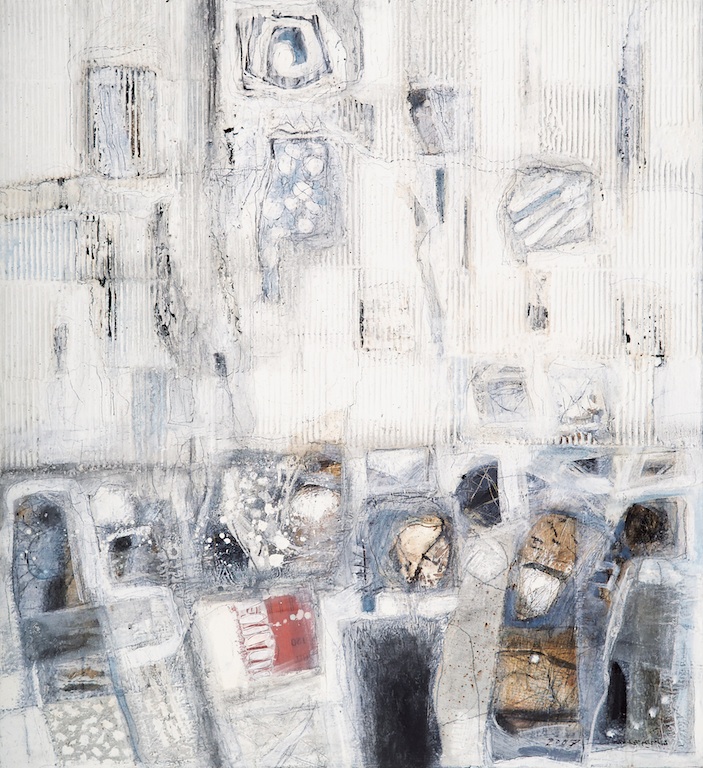 [Abdul Karim Majdal Al-Beik, Untitled (2007). Image courtesy of Ayyam Gallery.]
[Abdul Karim Majdal Al-Beik, Untitled (2007). Image courtesy of Ayyam Gallery.]
With the start of the recent war in Syria, Majdal Al-Beik’s practice has reflected greater usage of assemblage through the addition of found objects such as small crosses, fabric strips, string, guns, and knives in order to communicate the stark circumstances of life under conflict.
 [Abdul Karim Majdal Al-Beik, Syria, The Fires (2012). Image courtesy of Ayyam Gallery.]
[Abdul Karim Majdal Al-Beik, Syria, The Fires (2012). Image courtesy of Ayyam Gallery.]
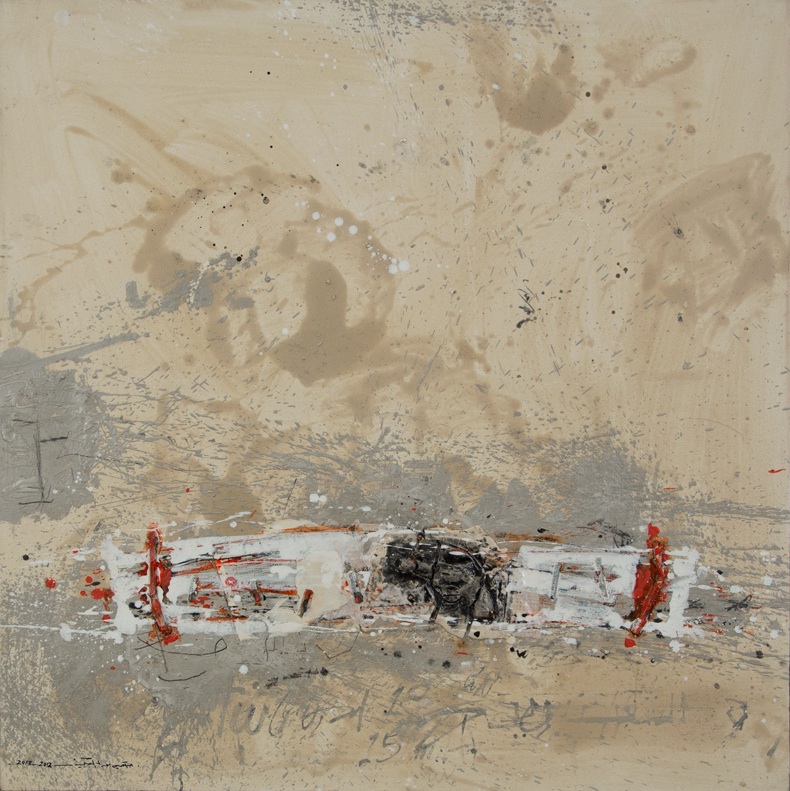 [Abdul Karim Majdal Al-Beik, Damascus-Beirut (2013). Image courtesy of Ayyam Gallery.]
[Abdul Karim Majdal Al-Beik, Damascus-Beirut (2013). Image courtesy of Ayyam Gallery.]
Informed by readings in literature, philosophy, and theory, many of Nihad Al Turk’s deeply psychological compositions can be read as allegorical self-portraits. Central to his work are thematic explorations of the endurance of man amidst the power struggles of good and evil—an existentialist question that has engrossed the artist for some time. Al Turk’s regular cast of imperfect creatures, mythical demons, still lifes, and botanical elements serve as the symbolic outcasts, anti-heroes, and rebels of a harrowing narrative.
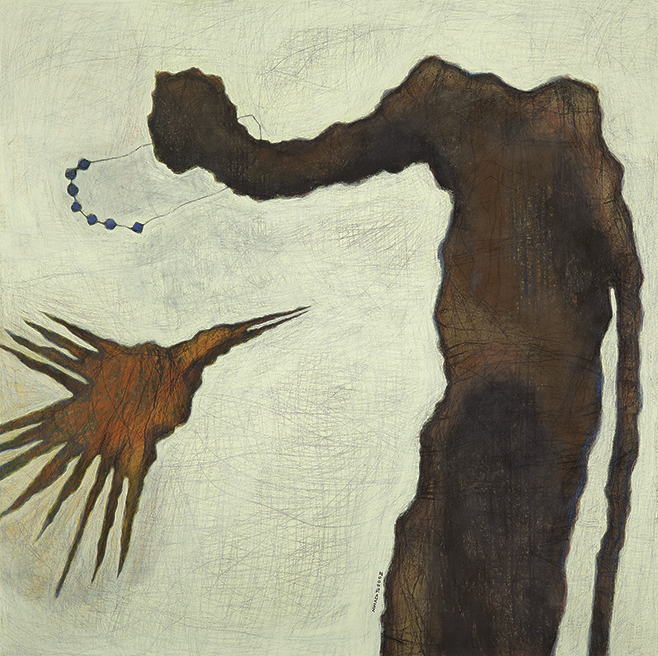 [Nihad Al Turk, The Hunchback (2008). Image courtesy of Ayyam Gallery.]
[Nihad Al Turk, The Hunchback (2008). Image courtesy of Ayyam Gallery.]
 [Nihad Al Turk, Dialogue (2012). Image courtesy of Ayyam Gallery.]
[Nihad Al Turk, Dialogue (2012). Image courtesy of Ayyam Gallery.]
Recently, he has set aside the dark palette of his earlier mixed media paintings by injecting vivid hues in the form of solid color fields that accentuate figures. This visible sense of optimism is juxtaposed with the quieting of his protagonists through a physicality that is robust and no longer disfigured as they finally escape the weight of their world.
 [Nihad Al Turk, The Olive (2013). Image courtesy of Ayyam Gallery.]
[Nihad Al Turk, The Olive (2013). Image courtesy of Ayyam Gallery.]
Othman Moussa’s early paintings capture the often-overlooked poetics of the mundane in realist still lifes that feature humble offerings, for example a battered but polished cooking pot alongside a lone pomegranate or a rusted teapot that glimmers as its exterior catches light. Recalling the naturalism of Spanish still lifes, his initial series emphasizes that which provides sustenance with reflective detail and a spiritual sense of monumentality. As the artist’s aesthetic progressed, his arrangements of inanimate objects began to take on allegorical traits, evincing subjective themes such as love and desire.
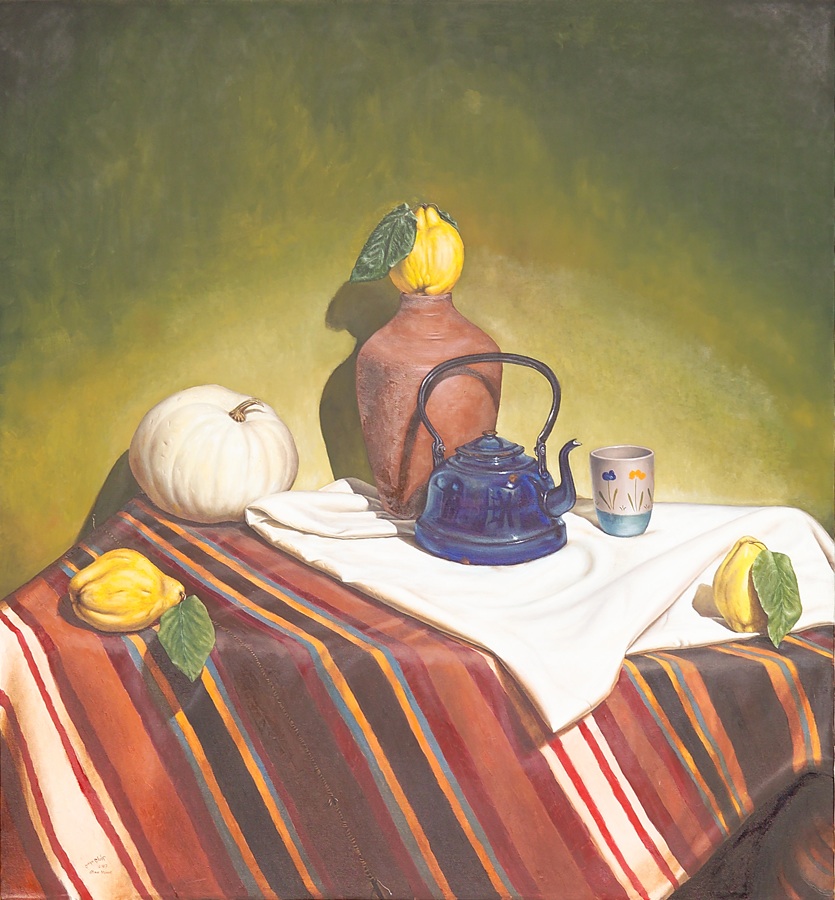 [Othman Moussa, Untitled (2007). Image courtesy of Ayyam Gallery.]
[Othman Moussa, Untitled (2007). Image courtesy of Ayyam Gallery.]
Recently, the impact of the Syrian conflict has entered his compositions, turning everyday objects into subjects of war. Although these works are realized with greater realism, Moussa has simplified his compositions by not including the embellishments of classical examples, such as the silken white cloth in Dutch still lifes that guides the eye across elaborate table settings. Isolating his objects, he focuses on jarring pairings. In these latest works, something as simple as food is now transformed into a weapon, reflecting the presence of violence in the most minor details of life. Other paintings of the series utilize satire as a biting form of social commentary as the thrones of absent monarchs are portrayed in an absurd manner and symbols of power are stripped of their aura.
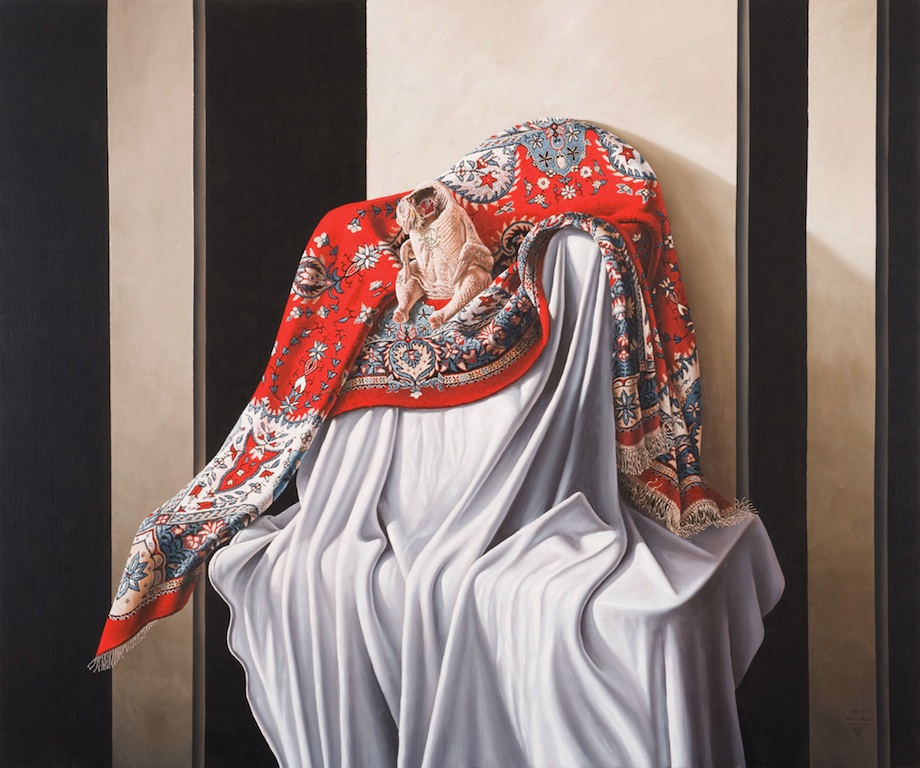 [Othman Moussa, The King of Peace (2011). Image courtesy of Ayyam Gallery.]
[Othman Moussa, The King of Peace (2011). Image courtesy of Ayyam Gallery.]
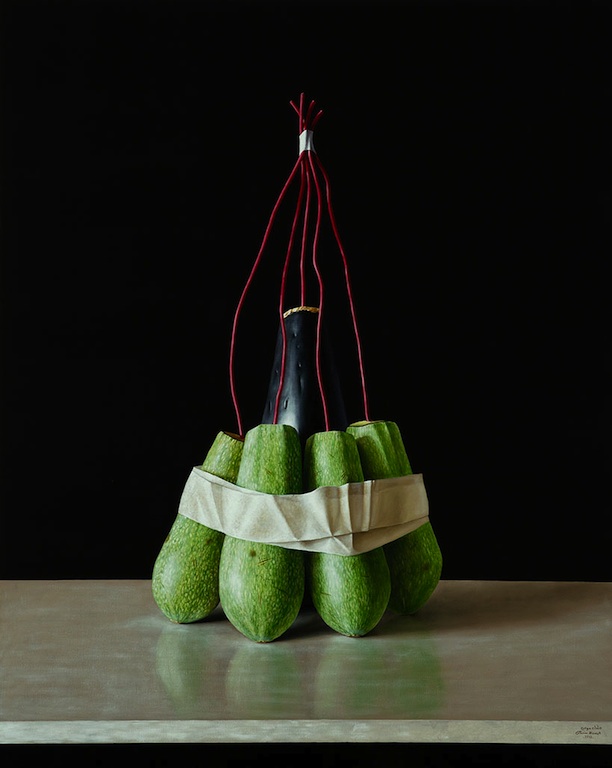 [Othman Moussa, The Terror Group (2013). Image courtesy of Ayyam Gallery.]
[Othman Moussa, The Terror Group (2013). Image courtesy of Ayyam Gallery.]
Dominated by vivacious childlike figures in various scenarios, Mohannad Orabi’s previous paintings reflect his interest in the spontaneity of process and the liberation of form that emerges when art is created intuitively without fixed directives. Many of these mixed media canvases were painted as self-portraits, revealing the artist’s fascination with the evolution of consciousness in childhood and the wonder and whimsy of the formative years that first shape our comprehension of the world.
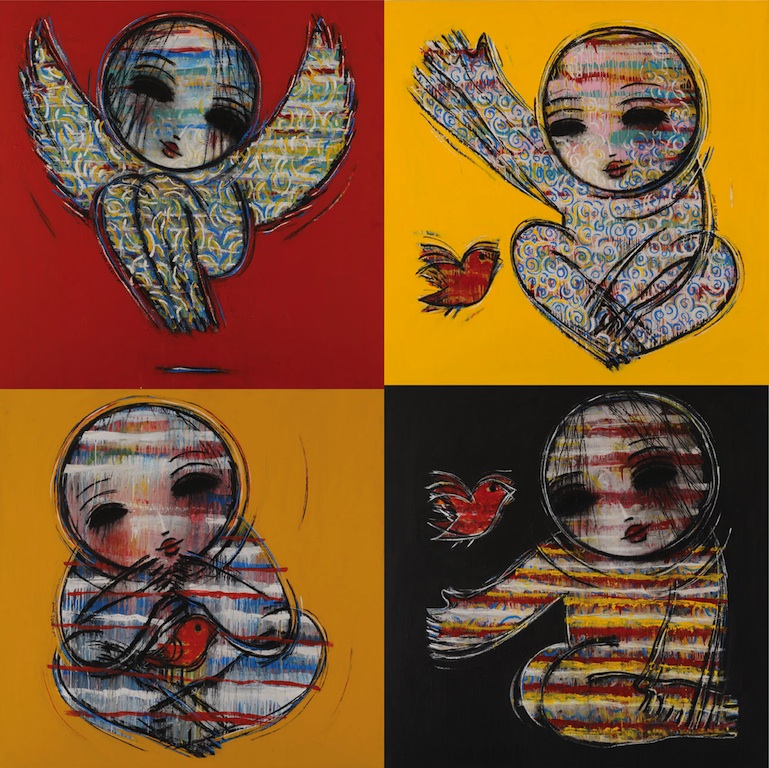 [Mohannad Orabi, Self Portrait (2009). Image courtesy of Ayyam Gallery.]
[Mohannad Orabi, Self Portrait (2009). Image courtesy of Ayyam Gallery.]
With the start of the Syrian uprising and the conflict that followed, Orabi adopted an increasingly realist approach to portraiture, drawing inspiration from the different forms of media that are currently forging a visual repository of the war. Martyr posters, Facebook profile pictures, and other types of filtered or composed imagery serve as source material for portraits of Syrians under siege, displaced, and in exile, recording a side of the conflict that lies beyond its ideological divisions and political talking points. While the artist retains an interest in the socialization processes of childhood, his own experiences of now living outside the country have led him to consider the ways in which visual culture, social media, and digital communication have become substitutes for what was once tangible.
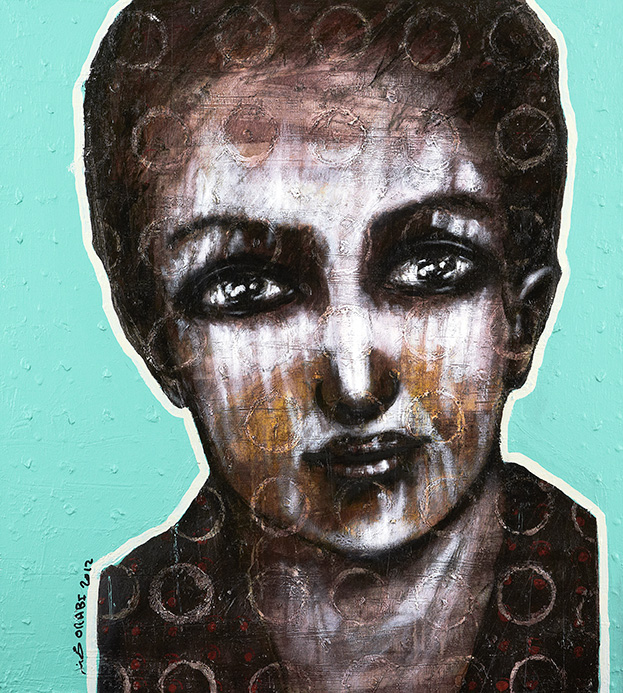 [Mohannad Orabi, Untitled (2012) from the Its No Longer About Me series. Image courtesy of Ayyam Gallery.]
[Mohannad Orabi, Untitled (2012) from the Its No Longer About Me series. Image courtesy of Ayyam Gallery.]
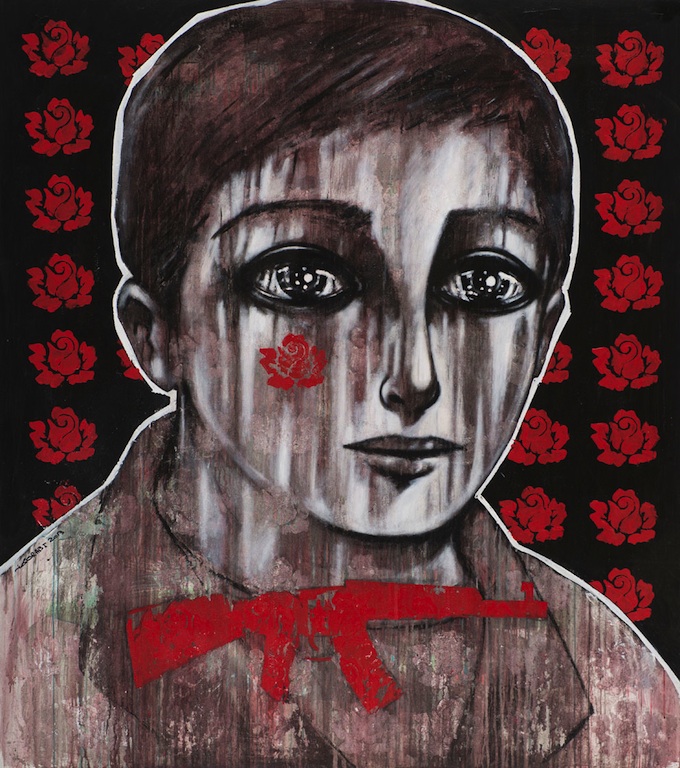 [Mohannad Orabi, Untitled (2013), from the Its No Longer About Me series. Image courtesy of Ayyam Gallery.]
[Mohannad Orabi, Untitled (2013), from the Its No Longer About Me series. Image courtesy of Ayyam Gallery.]
Kais Salman utilizes satire to subvert the normalization of greed, vanity, and ideological extremism that is rapidly defining our era. Working in a satirical tradition that can be traced to the thirteenth-century Maqamat al-Hariri illustrations of miniature painter Yahya ibn Mahmud Al-Wasiti, Salman seeks to confront and exorcise sociocultural manifestations of depravity.
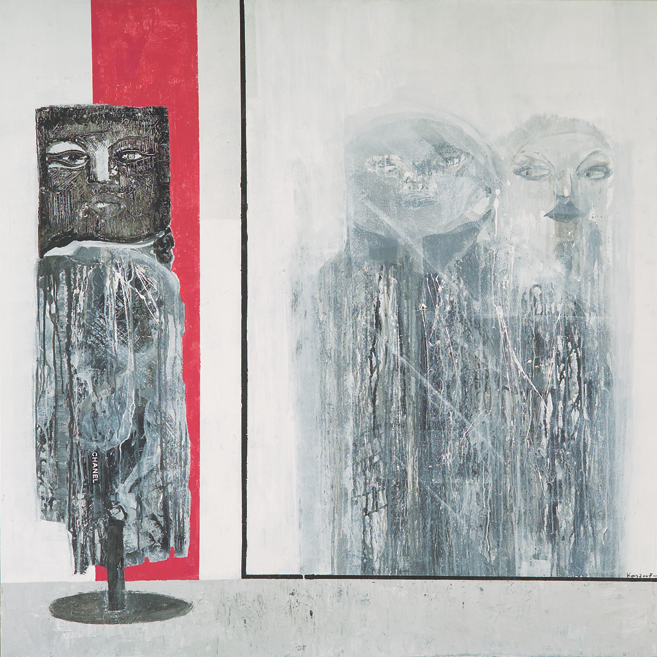 [Kais Salman, Untitled (2007), from the Fashion series. Image courtesy of Ayyam Gallery.]
[Kais Salman, Untitled (2007), from the Fashion series. Image courtesy of Ayyam Gallery.]
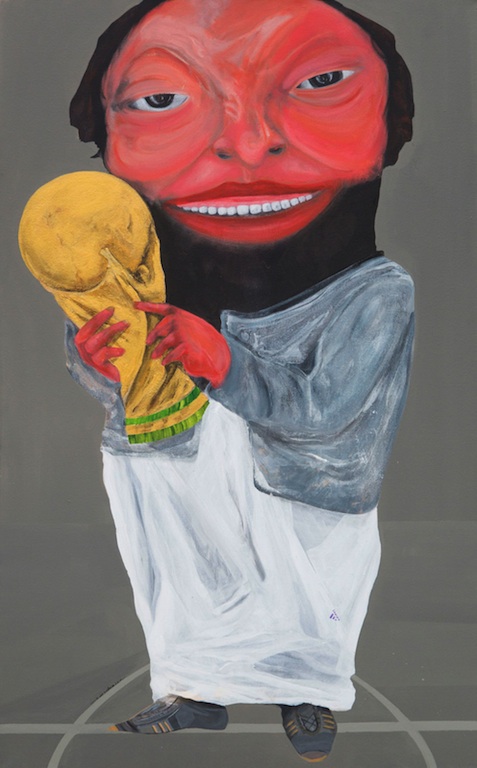 [Kais Salman, World Cup (2014). Image courtesy of Ayyam Gallery.]
[Kais Salman, World Cup (2014). Image courtesy of Ayyam Gallery.]
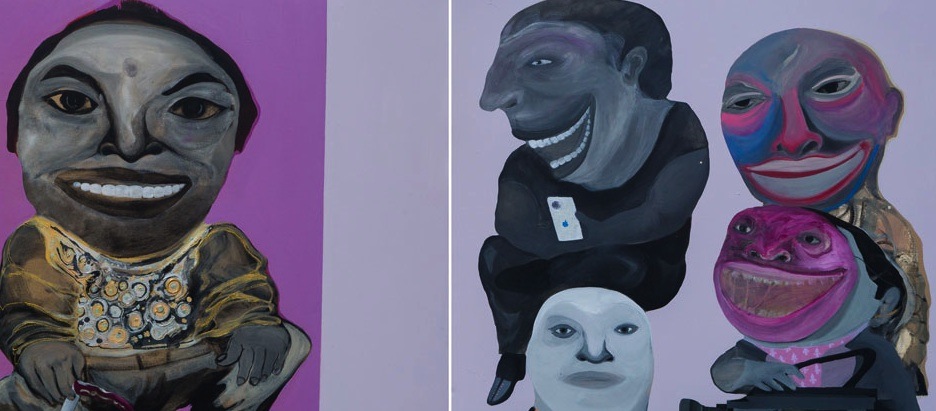 [Kais Salman, Media (2014). Image courtesy of Ayyam Gallery.]
[Kais Salman, Media (2014). Image courtesy of Ayyam Gallery.]
Tapping into ugliness and abjection through intentionally hyperbolized figures and mangled objects accentuated by punches of color and aestheticized forms, each series of Salman’s work reflects a type of psychological violence that occurs when excess becomes rationalized and accepted by societies. Terrorism, consumerism, cosmetic surgery, religious fanaticism, imperialism, and the voyeurism of the digital age have all served as topics of Salman’s carnivalesque compositions.
Footnotes
15. Gilles Deleuze, Francis Bacon: The Logic of Sensation (Minneapolis: University of Minnesota Press, 2004).
16. James V. Parry, "Faces in the Landscape: Marwan Kassab Bachi," Canvas Magazine (November/December 2008).
17. Kareem Shukr, "Safwan Dahoul: Narcissism is a Must for a Successful Artist," Forward Magazine (March, 2008).